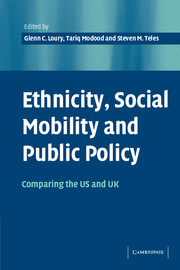Book contents
- Frontmatter
- Contents
- List of figures
- List of tables
- List of contributors
- Acknowledgements
- Introduction
- Part I Historical overviews
- Part II Informal social networks
- 4 Ethnicity as social capital: community-based institutions and embedded networks of social relations
- 5 Intergenerational mobility and racial inequality in education and earnings
- 6 Social integration and social mobility: spatial segregation and intermarriage of the Caribbean population in Britain
- 7 Ghettos and the transmission of ethnic capital
- 8 Family formulation in multicultural Britain: diversity and change
- Part III Formal structures
- Part IV Political institutions and processes
- Part V Normative analysis
- Author index
- Subject index
- References
8 - Family formulation in multicultural Britain: diversity and change
Published online by Cambridge University Press: 22 September 2009
- Frontmatter
- Contents
- List of figures
- List of tables
- List of contributors
- Acknowledgements
- Introduction
- Part I Historical overviews
- Part II Informal social networks
- 4 Ethnicity as social capital: community-based institutions and embedded networks of social relations
- 5 Intergenerational mobility and racial inequality in education and earnings
- 6 Social integration and social mobility: spatial segregation and intermarriage of the Caribbean population in Britain
- 7 Ghettos and the transmission of ethnic capital
- 8 Family formulation in multicultural Britain: diversity and change
- Part III Formal structures
- Part IV Political institutions and processes
- Part V Normative analysis
- Author index
- Subject index
- References
Summary
Interpreting diversity
The living arrangements of Britain's ethnic minorities have been of interest to researchers ever since the first wave of West Indians arrived in the 1950s. Early consideration was primarily focused on the direct effects of a recent migration. In some migrant groups, for example, there was an initial preponderance of unattached men. In some areas, restricted access to accommodation led many recent arrivals to crowd together in the same house or flat, and so create large “households.” But these characteristics were temporary and in a sense artificial consequences of the movement of populations, and have not been considered as primary issues in more recent analyses.
All four of the national surveys of ethnic minorities conducted by the Policy Studies Institute at about ten-year intervals have collected data about family and household structures, and each of the reports has presented summaries of the evidence (Daniel 1968, Smith 1977, Brown 1994, Modood et al. 1997). There has been extensive analysis by demographers of other large-scale sources, especially the 1991 Census (e.g., Coleman and Salt 1996) and the Labour Force Survey (e.g., Berrington 1994). It seems fair to say, though, that most of this work has been demographic and descriptive, rather than sociological or evaluative. The national surveys provided analyses of household structure in the form of background pictures of the population under study, before the authors moved on to the “real issues” of employment, housing, race relations, and so on.
- Type
- Chapter
- Information
- Ethnicity, Social Mobility, and Public PolicyComparing the USA and UK, pp. 222 - 254Publisher: Cambridge University PressPrint publication year: 2005
References
- 17
- Cited by



